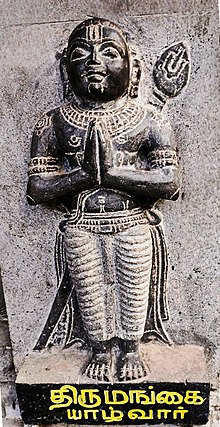
A | B | C | D | E | F | G | H | CH | I | J | K | L | M | N | O | P | Q | R | S | T | U | V | W | X | Y | Z | 0 | 1 | 2 | 3 | 4 | 5 | 6 | 7 | 8 | 9
Thirumangai Alvar | |
|---|---|
 | |
| Personal | |
| Born | Kaliyan the 8th century CE (traditional dating: 2702 BCE)[1] Kuriayalur (Thiruvali-Thirunagari) |
| Died | Thirukkurungudi (Thirunelveli dist.) |
| Religion | Hinduism |
| Other names | Parakalan |
| Organization | |
| Philosophy | Vaishnava Bhakti |
| Religious career | |
| Literary works | Periya Tirumoli Tirunetuntantakam Tirukkuruntantakam Tiruvelukkutrirukkai Ciriya Tirumatal Periya Tirumatal |
| Part of a series on |
| Vaishnavism |
|---|
 |
Thirumangai Alvar (IAST:Tirumaṅgai Āḻvār ), also referred to as Thirumangai Mannan[2] is the last of the 12 Alvar saints of south India, who are known for their affiliation to the Vaishnava tradition of Hinduism. He is considered one of the most learned Alvars, and the most superior Alvar in the context of composition of verses.[3] He holds the title Narkavi Perumal, the mark of an excellent poet,[3] and Parakala (Beyond Time).
Though he is respected as a Vaishnava saint-poet, he was born as a Kshatriya [4]and initially worked as a military commander under the cholas[5], a chieftain, and then a robber. After his conversion to Vaishnavism, he confronted practitioners the sect of Shaivism, as well as Buddhism and Jainism.
Dating and hagiography
The traditional date attributed to Thirumangai is year 399 of Kali Yuga, that is 2702[6] or 2706 BCE,[1] making him traditionally the last of the Alvar saints.[6] Modern scholars have placed the Alvars in between 5th to 9th centuries based on few historical evidence. Dr. N. Subba Reddiar summarizes their views and arrives at the date 776 AD for Thirumangai, making him chronologically the eighth Alvar, though even these dates are disputed.[7] Sakkottai Krishnaswami Aiyangar notes he is generally dated to 7th-8th century.[1] Professor of Religion and Asian Studies, James G. Lochtefeld of Carthage College dates Thirumangai to the 9th century.[8] He is generally considered to be a contemporary of Pallava king Nandivarman II (731 CE - 796 CE) as he refers to the later Pallavas of Pallava dynasty in his hymns.[9][10]
The hagiographies detailing the life of Thirumangai and other Alvars are Divya charitam (11th century) and Guruparampara-prabhavam-arayirappadi (13th century) and Guruparampara-prabhavam-muvayirappadi (14th century). Other Vaishnava scholars have written hagiographics based on the above works later.[6]
Early life
Thirumangai was born in the Kallar caste [11][12][13][14][15][16][17][18] in Thirukuraiyalur, a small village in Tamil Nadu. Thirumangai's real name was Kaliyan or Kalikanti. Thirumangai's father was Nilam, a general under the Chola empire.[2][19] He was skilled in archery and worked as a military commander himself for the Chola king. In recognition of his valour, he was conferred upon the title Parakala and rewarded a small territory called Ali Nadu to govern, for his military services. Its capital was Thirumangai. He earned the title Thirumangai Mannan or chief of Thirumangai, a name he maintained even when he became a saint.[2][3]
Married life

According to the traditional accounts, he fell in love with Kumudavalli, a Vaishnava doctor's adopted daughter at Thiruvellakkulam (also known as Annan Kovil). She gave a set of conditions that he must become a Vaishnavaite and that he must feed a thousand people for over a year, every day. During that process, he was so attracted to Vaishnavism that he started constructing temple walls for Srirangam. Unable to bear the heavy expense of feeding a thousand people, Kaliyan resorted to highway robbery. One day, he saw a group of people returning from a marriage, with the bride and groom. He and his assistants were able to get all the loot, but the toe ring from the groom was left. He tried to remove them, but could not do so. Then he realised the bridegroom was none other than Vishnu himself. Narayana revealed himself to Kaliyan and transformed him by teaching the Narayana mantra or Ashtakshara (the eight syllabled) – Om Namo Narayanaya, turning the robber into a saint, and starts singing the first verse of Periya Tirumoli (Vaadinen Vaadi). The temple-god of Thirunaraiyur (Naraiyur Nindra Nambi) – a form of Vishnu – is believed to have initiated Thirumangai into Vaishnavism, by teaching him the pancha samskara.[2][19][20]
The first ten verses of Thirumangai's poem Periya Tirumoli sing of his transformation, after receiving the spiritual knowledge from Vishnu.[19] He sings about his transformation thus:[21]
I became a thief
deceitful and dishonest
I wandered hither and thither
yet light dawned upon me –
I reached Your feet
and instantly your grace fell upon me
with melting heart and choked voice
your praises I sing
bathed in streaming tears
I repeat day and night
the sacred name of Narayana (Vishnu)
As a Vaishnava saint
| Part of a series on |
| Hinduism |
|---|
 |
